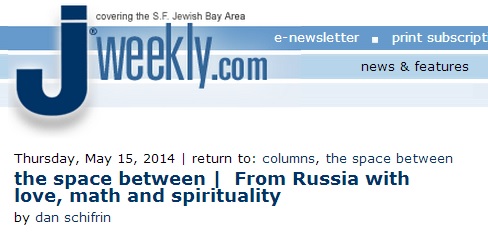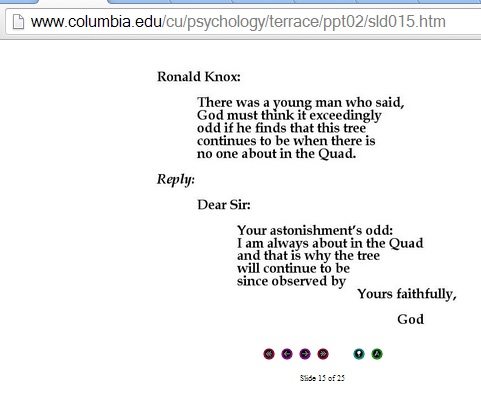Edward Frenkel in a vulgar and stupid
LA Times opinion piece, March 2, 2014 —
"In the words of the great mathematician Henri Poincare, mathematics is valuable because 'in binding together elements long-known but heretofore scattered and appearing unrelated to one another, it suddenly brings order where there reigned apparent chaos.' "
My attempts to find the source of these alleged words of Poincaré were fruitless.* Others may have better luck.
The search for Poincaré's words did, however, yield the following passage —
HENRI POINCARÉ
THE FUTURE OF MATHEMATICS
If a new result is to have any value, it must unite elements long since known, but till then scattered and seemingly foreign to each other, and suddenly introduce order where the appearance of disorder reigned. Then it enables us to see at a glance each of these elements in the place it occupies in the whole. Not only is the new fact valuable on its own account, but it alone gives a value to the old facts it unites. Our mind is frail as our senses are; it would lose itself in the complexity of the world if that complexity were not harmonious; like the short-sighted, it would only see the details, and would be obliged to forget each of these details before examining the next, because it would- be incapable of taking in the whole. The only facts worthy of our attention are those which introduce order into this complexity and so make it accessible to us.
Mathematicians attach a great importance to the elegance of their methods and of their results, and this is not mere dilettantism. What is it that gives us the feeling of elegance in a solution or a demonstration? It is the harmony of the different parts, their symmetry, and their happy adjustment; it is, in a word, all that introduces order, all that gives them unity, that enables us to obtain a clear comprehension of the whole as well as of the parts. But that is also precisely what causes it to give a large return; and in fact the more we see this whole clearly and at a single glance, the better we shall perceive the analogies with other neighbouring objects, and consequently the better chance we shall have of guessing the possible generalizations. Elegance may result from the feeling of surprise caused by the unlooked-for occurrence together of objects not habitually associated. In this, again, it is fruitful, since it thus discloses relations till then unrecognized. It is also fruitful even when it only results from the contrast between the simplicity of the means and the complexity of the problem presented, for it then causes us to reflect on the reason for this contrast, and generally shows us that this reason is not chance, but is to be found in some unsuspected law. ….
HENRI POINCARÉ
L'AVENIR DES MATHÉMATIQUES
Si un résultat nouveau a du prix, c'est quand en reliant des éléments connus depuis longtemps, mais jusque-là épars et paraissant étrangers les uns aux autres, il introduit subitement l'ordre là où régnait l'apparence du désordre. Il nous permet alors de voir d'un coup d'œil chacun de ces éléments et la place qu'il occupe dans l'ensemble. Ce fait nouveau non-seulement est précieux par lui-même, mais lui seul donne leur valeur à tous les faits anciens qu'il relie. Notre esprit est infirme comme le sont nos sens; il se perdrait dans la complexité du monde si cette complexité n'était harmonieuse, il n'en verrait que les détails à la façon d'un myope et il serait forcé d'oublier chacun de ces détails avant d'examiner le suivant, parce qu'il serait incapable de tout embrasser. Les seuls faits dignes de notre attention sont ceux qui introduisent de l'ordre dans cette complexité et la rendent ainsi accessible.
Les mathématiciens attachent une grande importance à l'élégance de leurs mé-thodes et de leurs résultats; ce n'est pas là du pur dilettantisme. Qu'est ce qui nous donne en effet dans une solution, dans une démonstration, le sentiment de l'élégance? C'est l'harmonie des diverses parties, leur symétrie, leur heureux balancement; c'est en un mot tout ce qui y met de l'ordre, tout ce qui leur donne de l'unité, ce qui nous permet par conséquent d'y voir clair et d'en comprendre l'ensemble en même temps que les détails. Mais précisément, c'est là en même temps ce qui lui donne un grand rendement ; en effet, plus nous verrons cet ensemble clairement et d'un seul coup d'œil, mieux nous apercevrons ses analogies avec d'autres objets voisins, plus par conséquent nous aurons de chances de deviner les généralisations possibles. L'élé-gance peut provenir du sentiment de l'imprévu par la rencontre inattendue d'objets qu'on n'est pas accoutumé à rapprocher; là encore elle est féconde, puisqu'elle nous dévoile ainsi des parentés jusque-là méconnues; elle est féconde même quand elle ne résulte que du contraste entre la simplicité des moyens et la complexité du problème posé ; elle nous fait alors réfléchir à la raison de ce contraste et le plus souvent elle nous fait voir que cette raison n'est pas le hasard et qu'elle se trouve dans quelque loi insoupçonnée. ….
* Update of 1:44 PM ET March 14 — A further search, for "it suddenly brings order," brought order. Words very close to Frenkel's quotation appear in a version of Poincaré's "Future of Mathematics" from a 1909 Smithsonian report—
"If a new result has value it is when, by binding together long-known elements, until now scattered and appearing unrelated to each other, it suddenly brings order where there reigned apparent disorder."




























